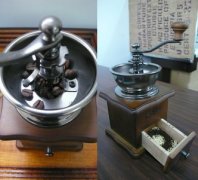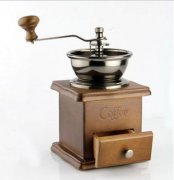How to choose an electric bean grinder coffee machine recommended
This is not a review of an electric bean grinder. This is an overview of the most common household bean grinders on the Australian market in January 2007. In particular, this article is aimed at users of home Espresso machines. Because if your home Espresso machine is not that kind of super fully automatic, then you will definitely need a bean grinder. I'm not going to go into areas like cost or ergonomics, I'm just going to talk about how well or not they work.

I am interested in the accuracy and repeatability of the coffee powder produced by the bean grinder, and the degree to which the coffee powder matches different types of Espresso machines. In the grinding machine, there are several very simple principles of physics in the working props. The quality of the bean grinder depends on three main factors:
1) Surface area of grindstone
2) sharpness of grindstone
3) the precision of the gap between the two grindstones can be kept fixed during grinding.
(note that in household products, compared with the surface area of each coffee bean exposed to the grinder, the conical grinder is larger than the platform grinder.)
Generally speaking, one grinding blade is fixed (called stator), and the other grinding blade is rotated (called rotor). In most designs, the thickness of the grinding particles is adjusted by moving the stator closer to the rotor. This is usually (but not always) done by adjusting a screw to move the bearing bracket that carries the grinding disc (usually controlling the upper grinding disc). The quality, weight and accuracy of the bracket carrying the grinding piece determine the quality of the bean grinder.
In the course of my evaluation of the home Espresso machine (http://www.coffeeco.com.au/articles/july2002.html)), I carefully looked at the "under the skin" of several bean grinders and found that there were up to half a dozen kinds of grinding tablets. The following is a summary of bean grinders that are relatively easy to get in Australia, and I will also mention some of the American models I know.
Emide, Gaggia MM, Sunbeam, Breville, Braun, La Pavoni PA (USA)
This kind of grinding piece can be regarded as a grinding piece. This kind of grinding blade seems to be sintered from a certain material, and there is not even a sharp corrugated angle. The adjustment of the thickness of the bean grinder is not by using the thread bearing bracket, but by using some kind of wedge system, which pushes the grinding disc, motor, and all the parts at the bottom to move relative to the stator. Beans are not cut, but crushed, causing a lot of dust. Frankly speaking, this kind of bean grinder is not suitable for producing quality Espresso at all.
Saeco 2002, G3 Ferrari.
A set of cast steel grinding plates are placed on the threaded brass bracket, but the grinding pieces are too small and are not as well designed as the big ones (pay attention to the gaps). There should be no problem with short-term application, but it looks like it will wear out quickly. I have seen reports that Saeco cannot grind the fineness required by commercial Espresso, but it is not a big problem for ordinary home use. (original: but had no trouble on the second finest setting, I don't know how to translate it.)
Solis (All), Dualit, DeLonghi KG100, Starbucks Barista, Bodum.
All these bean grinders use the standard Solis conical grinding kit, and all (except probably Bodum) are manufactured by Solis. There is no doubt that this grinding kit is very suitable for making excellent Espresso bean grinders. Unfortunately, the bearing bracket of the upper grinding plate is not adjusted by a thread system, but by a bevel and wedge system. In my opinion, this adjusting device is not accurate enough, especially when the bean grinder begins to wear out as time goes by. I would not hesitate to recommend this bean grinder for those who use household 53mm or smaller home Espresso machines with brewing handle heads and pressurized filter bowls, while for those who use larger cooking handles and unpressurized filter bowls, I would not recommend this bean grinder.
In order to grind enough fineness, such machines need to push the Solis grinding kit to the end of the adjustable range, which potentially increases wear and shortens service life. So I can't recommend this one for long-term use. Note that some of the models listed above are not as thin as Espresso needs and need to be adjusted to get the correct thickness. You can find out how to do this on Ken Wilson's UK website (www.kwilson.fsnet.co.uk/coffee_index.htm). You can also find a lot of useful information about the bean grinder there.
Lux, Ascaso Conical, La Pavoni PB, Iberital, Isomac, Sunbeam EM0480 & EM0450, etc.
The weakness of this conical grinding disc kit is that the thread bearing bracket is made of famous black hard plastic. However, in practice, this part looks as long and works as a brass bracket. The oldest model I have, which is still in service, has been in service for ten years, and it still works well after the last change of the mill.
Of course, these bean grinders can grind coffee powder fine enough and accurate enough to use any Espresso coffee machine to produce excellent coffee, and have good consistency over a long life span. The mill bracket used in the Sunbeam bean grinder is more brittle than the one used in Lux, but they use the same mill.
Rancilio Rocky, Ascaso Flat, Gaggia MDF, Mazzer Minis, etc
These bean grinders use a standard professional grade flat mill kit, coupled with a professional brass thread bearing plate carrier, and, as you would expect, are capable of grinding any Espresso machine. For this grade (and price) bean grinder, other factors that are not directly related to grinding have been taken into consideration, such as the quality of the feeder, speed, temperature during grinding, etc.
There are already a lot of excellent bean grinder comments on Coffeegeek (http://www.coffeegeek.com/detailed/innovagrinder) and elsewhere). In my opinion, these comments cover ergonomics, brands and many other areas that I have never covered before. As I said at the beginning of this article, I won't try to get into these things. I'm only interested in the kinds of pieces and their ability to grind the coffee powder needed for Espresso.
Why do I need a bean grinder?
Fresh: coffee beans last longer than ground coffee powder. Once you grind the coffee, the aging reaction speeds up many times, which is the amount of powder you grind the coffee beans into. In terms of the grinding fineness required for Espresso, this multiple is a large number.
Precision: Espresso coffee requires a strict set of conditions to complete a complete extraction. Given a particular Espresso machine, you can generally control the grinding, dose and tamp processes to achieve this. Of these three variables, grinding is the most important, followed by the amount of powder loaded, and finally compaction. Coffee is hygroscopic and can absorb moisture in the air, so changes in temperature and humidity will have a significant impact on coffee grinding.
Adaptability: using pre-ground coffee to make coffee loses the ability to change conditions to adjust. A great extraction one day may become average the next day, but become unswallowed on the third day. At the same time, the pre-ground coffee is also suffering from accelerated aging because its surface area has increased a lot compared to the more complete coffee beans. This aging reaction actually changes the way of extraction. Without fresh beans and a good grinder, it is absolutely impossible to get a sustained good Espresso.
What good bean grinder can I buy in Australia?




Sunbeam EM0450. Step by step adjustment, the Lux grinder is placed in a plastic shell and all other features are completely discarded to provide the lowest possible cost
Sunbeam EM0480. Step-by-step adjustment, Lux grinding piece, aluminum shell, for money-saving grinders to provide the best short-term value, there is no history of long-term service.
Bean grinders for Solis 166, Maestro and other Solis chips. Step-by-step adjustment, it can be used if your Espresso machine has a 53mm portafilter or a pressurized filter.
Lux, Iberital, Isomac, etc. Good grinding quality, but too noisy. Manufacturing quality and ergonomics could have been better. In the Iberital version, the Ascaso conical grinder is packed in a cheap plastic shell.




Ascaso flat grinding disc and conical grinding disc. Excellent manufacturing quality, poor feeder, "stepless" adjustment. It's worth it.
Gaggia MDF. Step-by-step adjustment, the step is very wide, sometimes too wide to make it difficult to adjust. Poor feeder, but excellent grinding quality.
There is no feeder version of Rancilio Rocky. Strong, step-by-step adjustment, commercial (MD40) motors and grinding pieces, excellent grinding quality.
Rancilio Rocky has a feeder version. The most reliable household bean grinder. The feeder is worse than the commercial model.
Stepless regulation contrast step regulation
Stepless adjustment of household bean grinder is usually through a worm gear to adjust the level, in theory, it can be adjusted infinitely within its adjustable range. This feature is helpful for a skilled Barista when trying to make a perfect extraction, but when practicing adjusting variables, such as powder quantity and pressure real-time, it can get into trouble due to small adjustments in grinding. Large grinding adjustments (such as different beans, or different baking) can become very difficult.
My advice is that if the grinder is used in a variety of baking methods and a variety of coffee beans need to change frequently, choose a step-by-step grinder.
Feeder compared to non-feeder
The feeder is a cylindrical container in front of some bean grinders to receive ground coffee powder. Pull the lever on the side of the feeder to rotate a device so that the coffee is poured into the portafilter below. The size of the coffee feeder on the commercial bean grinder is adjustable so that you can get exactly the amount of coffee extracted each time. Household feeder is usually not adjustable. In addition, even commercial feeders still need to be half full or three-thirds full to work properly, resulting in a lot of coffee to be ground. (In addition, even commercial dosers need to be half to three quarters full to work correctly, which is a lot of coffee to have ground up.)
My advice is that if you only make one or two cups of coffee at a time, it's better without a feeder. That said, a feeder can save a lot of work if you often need to make several cups of coffee at a time. This is why commercial coffee grinders have feeders.
Author: Alan Frew, http://www.coffeeco.com.au/
Original source: http://www.coffeeco.com.au/articles/september2002.html
Translation: Grant
Important Notice :
前街咖啡 FrontStreet Coffee has moved to new addredd:
FrontStreet Coffee Address: 315,Donghua East Road,GuangZhou
Tel:020 38364473
- Prev

Bean grinder recommended for household use hand grinder
Home era, want to make a cup of freshly ground coffee at home, we need a small hand grinder to help, the reason for choosing a small grinder: adjustable grinding thickness, grinding uniform semicircular bean slot, convenient and intuitive all-steel movement, grinding convenient and fast labor-saving Small drawer, a grinding of 25 grams of coffee powder and can choose different grinding thickness (medium) (fine) (coarse)
- Next

Coffee maker recommends classic hand coffee grinder
Related
- What is the Philharmonic pressure? How to use Philharmonic pressure to make delicious coffee
- Why does a hand grinder have more fine powder than an electric grinder?
- In addition to the hot mom, what is the difference between the versions of EK43 | ditting and Mahdi ek43?
- What kind of equipment do you need to make coffee by hand? Introduction to novice starter cooking equipment tools
- Espresso needs to be ground how thick and thin scale entry Italian Coffee Machine Bean Grinder investigation and Grinding course
- How much does it cost to open a small private cafe? How much does it cost to learn coffee? How to operate it?
- The difference between the flavor characteristics of hand-brewed coffee and coffee maker is hand-brewed coffee really better than coffee maker? Can I use a coffee machine to make coffee beans by hand?
- The difference between 01 and 02 of hario v60 filter cup what is the difference between 01 and 02 filter cup opening and cooking flavor
- What's the difference between the smart cup and the French kettle? Which is better, the French kettle or the Smart Cup?
- What's the difference between a smart cup and a V60 filter cup? The difference between the taste of smart cup and hand-brewed coffee

